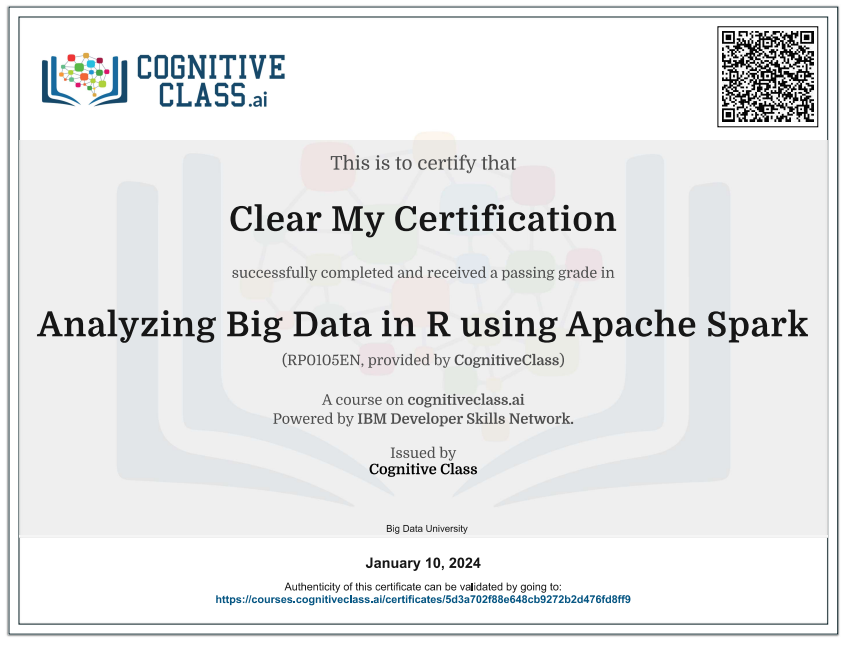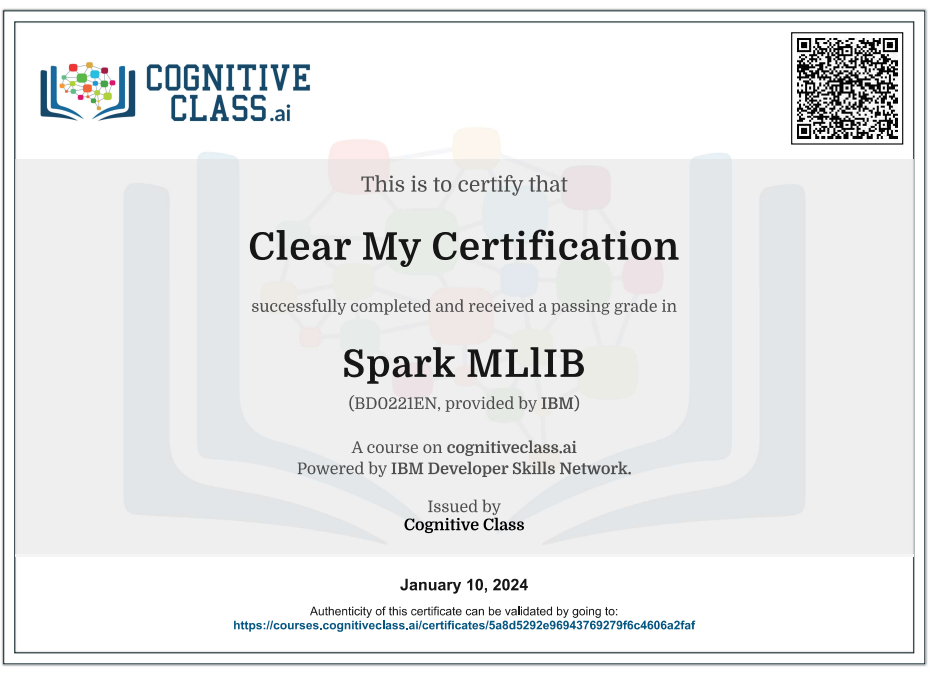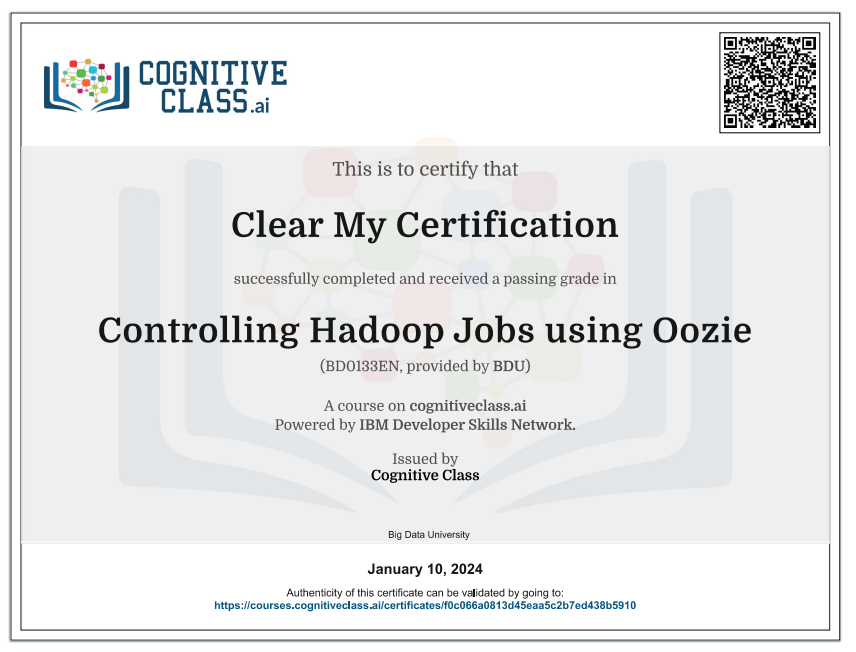Enroll Here: Exploring Spark’s GraphX Cognitive Class Exam Quiz Answers
Exploring Spark’s GraphX Cognitive Class Certification Answers

Module 1 – Introduction to Graph Parallel Quiz Answers – Cognitive Class
Question 1: GraphX extends RDDs, which allows users to use GraphX as a collection, but not as a graph!
- True
- False
Question 2: Which of the following statements is true?
- Graph-Parallel is usually handled by Hadoop and Spark.
- Graph-Parallel focuses on distributing data across different nodes and systems.
- Data-Parallel is usually handled by Pregel, GraphLab and Giraph.
- Data-Parallel focuses on efficiently executing graph algorithms.
- None of the above
Question 3: GraphX unifies Data-Parallelism and Graph-Parallelism in one library.
- True
- False
Module 2 – Visualizing GraphX and Exploring Graph Operators Quiz Answers – Cognitive Class
Question 1: The “degree” operator returns a VertexRDD[Int] containing the number of outgoing edges of each vertex.
- True
- False
Question 2: Which of the following is not an attribute of a Triplet class?
- attr
- id
- srcAttr
- srcId
- None of the above
Question 3: Other libraries such as Gephi or GraphLab can help GraphX with visualization.
- True
- False
Module 3 – Modifying GraphX Quiz Answers – Cognitive Class
Question 1: We must run the “partitionBy” function before running the “groupEdges” operator.
- True
- False
Question 2: Which of following is among the PartitionStrategies provided by GraphX?
- EdgePartition2D
- RandomVertexCut
- EdgePartition1D
- CanonicalRandomVertexCut
- All of the above
Question 3: To improve efficiency, GraphX reuses portions of the graph which are unaffected by a modifier.
- True
- False
Module 4 – Neighborhood Aggregation Caching Quiz Answers – Cognitive Class
Question 1: AggregateMessages is the only neighborhood aggregation function provided by GraphX.
- True
- False
Question 2: Which of the following is not an attribute of TripletFields?
- TripletFields.None
- TripletFields.DstOnly
- TripletFields.EdgeOnly
- TripletFields.All
- None of the Above
Question 3: The ClassTag is optional for aggregateMessages if the message is a String.
- True
- False
Exploring Spark’s GraphX Final Exam Answers – Cognitive Class
Question 1: To instantiate a Graph, you need at LEAST 2 RDDs.
- True
- False
Question 2: pageRank is a graph algorithm that ranks the edges of the graph by correlating their relation with vertices, in terms of both quality and quantity.
- True
- False
Question 3: The numEdges operator returns an EdgesRDD[Long].
- True
- False
Question 4: Which of the following ClassTypes are returned from mapTriplets, assuming Graph[VD, ED] is the original?
- Graph[VD, ED]
- Graph[VD2, ED]
- Graph[VD, ED2]
- Graph[VD2, ED2]
- None of the Above
Question 5: The reverse operator returns a graph in which the direction of all edges are reversed.
- True
- False
Question 6: Which of the following ClassTypes are returned from mapTriplets, assuming Graph[VD, ED] is the original?
- Graph[VD, ED]
- Graph[VD2, ED]
- Graph[VD, ED2]
- Graph[VD2, ED2]
- None of the Above
Question 7: Caching graphs that are only used infrequently can slow computations.
- True
- False
Question 8: Which of the following is required to define aggregateMessages?
- sendMsg
- mergeMsg
- tripletFields
- sendMsg and mergeMsg
- All of the Above
Question 9: Triplets are a required parameter when instantiating a Graph.
- True
- False
Question 10: When defining the merge parameter for groupEdges (Int), which of the following is a valid definition for merge = (Edge1, Edge2)?
- Edge1
- Edge1 * Edge2
- Edge1 – Edge2 / Edge1
- Edge1 + Edge2
- All of the Above
Question 11: In a tuple, the first parameter returned by the “degrees” operator is the degree info, and the second parameter is the vertexid.
- True
- False
Question 12: Data-Parallel is usually handled by Pregel, GraphLab, and Giraph.
- True
- False
Question 13: Which of the following is true about GraphX?
- GraphX does not have built-in visualization functions.
- GraphX is a Graph-Processing library built into Apache Spark.
- GraphX extends the RDD class which allows us to use GraphX as a graph or a collection.
- GraphX is mainly a graph processing library.
- All of the above
Question 14: By using the mapTriplets function, we are only able to modify the edge attribute.
- True
- False
Question 15: Which of the following is true about the EdgeContext class?
- It has access to vertex attributes, but not to edge attributes.
- It has access to edge attributes, but not to vertex attributes.
- It has sendToDst, sendToSrc, and sendToAll functions.
- It is the same as the EdgeTriplet Class.
- None of the above
Introduction to Exploring Spark’s GraphX
GraphX is a component of Apache Spark that provides a distributed graph processing framework built on top of the Spark core. It allows you to express graph computation within the Spark data processing engine. GraphX extends the Spark RDD (Resilient Distributed Datasets) API to include a new graph abstraction called Graph, which represents a distributed graph with attributes on both the vertices and edges.
Here are some key concepts and features of GraphX:
Graph Representation:
- Vertex and Edge RDDs:
- GraphX represents a graph as two RDDs: one for vertices and another for edges. Vertex RDD contains vertex attributes, and Edge RDD contains edge attributes and source and destination vertex IDs.
- Graph Class:
- The
Graphclass in GraphX represents the entire graph and provides methods for graph processing. It encapsulates both the Vertex RDD and Edge RDD.
- The
Graph Computation:
- Parallel Computation:
- GraphX leverages the parallel processing capabilities of Spark. Graph algorithms expressed using GraphX can scale horizontally across a cluster of machines.
- Bulk Synchronous Parallel (BSP) Model:
- GraphX follows the Bulk Synchronous Parallel model, where computation is organized into iterations, and at the end of each iteration, all updates are synchronized.
Graph Operations:
- Graph Transformation:
- GraphX supports a variety of graph transformations and operations such as
mapVertices,mapEdges,subgraph,reverse, and more. These operations allow you to modify the graph structure and attributes.
- GraphX supports a variety of graph transformations and operations such as
- Pregel API:
- Inspired by Google’s Pregel, GraphX includes a Pregel API that enables iterative graph computation. It allows users to express graph algorithms in a vertex-centric way.
Graph Algorithms:
- Built-in Algorithms:
- GraphX includes built-in algorithms for common graph processing tasks, such as PageRank, connected components, shortest paths, and more.
- Custom Algorithms:
- You can implement custom graph algorithms using the GraphX API, leveraging the power of distributed computation across a Spark cluster.
Integration with Spark Ecosystem:
- DataFrames and Spark SQL:
- GraphX integrates with Spark SQL, enabling you to combine graph processing with SQL queries on structured data using DataFrames.
- MLlib:
- GraphX can be integrated with Spark’s MLlib (Machine Learning Library) to perform graph-based machine learning tasks.
GraphX is a powerful tool for processing and analyzing large-scale graphs using the capabilities of the Spark framework. Whether you’re analyzing social networks, financial transactions, or any other graph-structured data, GraphX provides a scalable and distributed approach to graph processing within the Spark ecosystem.
 Clear My Certification All Certification Exam Answers
Clear My Certification All Certification Exam Answers



